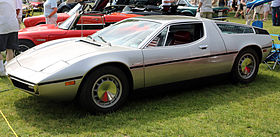Maserati Bora
| Maserati Bora | |
|---|---|
 |
|
| Overview | |
| Manufacturer | Maserati |
| Production | 1971–78 (Bora 4.7 L) 289 produced 1973–78 (Bora 4.9 L) 275 produced |
| Designer | Giorgetto Giugiaro at Italdesign |
| Body and chassis | |
| Body style | 2-door coupe |
| Layout | RMR layout |
| Related | Maserati Merak |
| Powertrain | |
| Engine | 4.7 L (4719 cc) V8 4.9 L (4930 cc) V8 |
| Transmission | 5-speed ZF manual |
| Dimensions | |
| Wheelbase | 2,600 mm (102.4 in) |
| Length | 4,335 mm (170.7 in) |
| Width | 1,768 mm (69.6 in) |
| Height | 1,134 mm (44.6 in) |
| Curb weight | 1,830 kg (4,034 lb) |
| Chronology | |
| Predecessor | Maserati Ghibli |
| Successor | Maserati MC12 |
The Maserati Bora (Tipo 117) is a mid-engined two-seat coupe manufactured by Maserati, powered by a V8 engine. Produced from 1971 to 1978, it has a top speed of 171 miles per hour (275 km/h). It is classified as a supercar and is considered by some to be the pinnacle of Maserati performance.
Shortly after Citroën took a controlling interest in Maserati in 1968, the concept of a mid-engined two-seat sports car was proposed. Lamborghini and De Tomaso already had the Miura and Mangusta whilst Ferrari were known to be developing their own mid-engined contender. Initially known as Tipo 117 and later the Bora, the Maserati project got underway in October 1968 and a prototype was on the road by mid-1969. Shown in its final form at the Geneva Salon in March 1971, deliveries began before the end of the year. Maserati struggled after being bought by De Tomaso in 1975, and the Bora was discontinued after the 1978 model year.
Maserati had developed a reputation for producing technologically out of date cars, but that changed with the Bora. A number of innovative features were introduced that distinguished the car from their previous offerings. Compared to other supercars it was civilized and practical, featuring a hydraulically powered pedal cluster that could be moved forward and backwards at the touch of a button and a steering wheel that could be tilted and telescoped, addressing the common problem of entering and exiting the vehicle common to all supercars.
Most supercars offer little foot room and little to no provision for luggage, but the Bora has a full-size trunk in the front of the vehicle, and was otherwise known as being much more civilized in comforts from its competitors, while still being rated at 171 mph by the Maserati factory. Unlike its competitors, the Bora used dual-pane glass separating its cabin from the engine compartment as well as a carpeted aluminum engine cap, greatly decreasing the engine noise in the cabin and increasing the comfort level for the driver.
Two engines were offered initially, including a high-revving 4.7-litre (290 cu in) V8 and a higher torque 4.9-litre (300 cu in) V8; a US smog-qualified 4.9-litre engine was used (a stroked version of the 4.7), starting with 1973 deliveries. Eventually, production switched to using only a more powerful version of the 4.9-litre engine producing 320 hp at 6000 rpm. All these engines traced their lineage back to the famous 450S racecar, were aluminum alloy, had hemispheric combustion chambers with 16 valves total operated by four cams (chain-driven) and fed by eight throats of Weber carburetion, fired by electronic ignition. The extraordinarily competent and strong ZF-1 five-speed transaxle was used, as it was with the GT-40, Pantera, BMW M1, and other supercars of this era. Regardless of engine size or modification level, the Bora was considered an extraordinarily powerful car in its time.
...
Wikipedia
